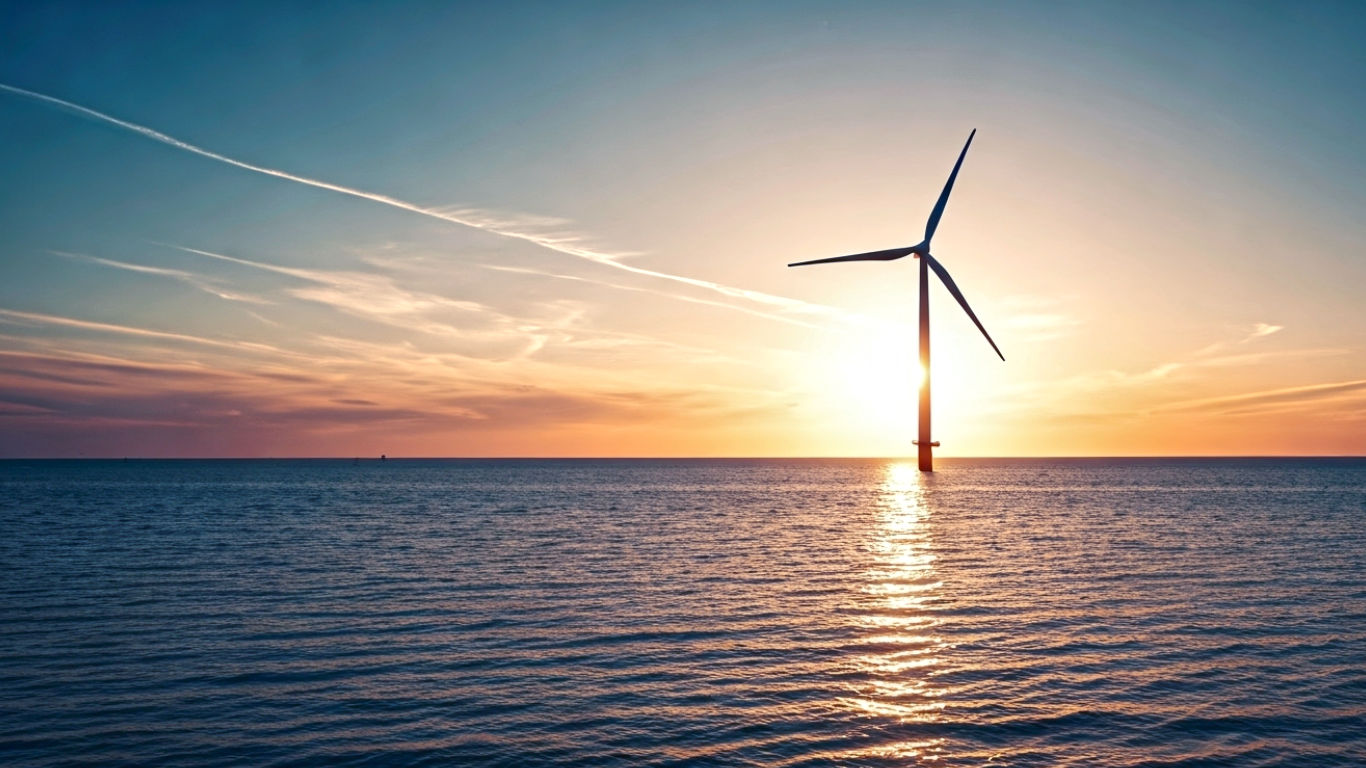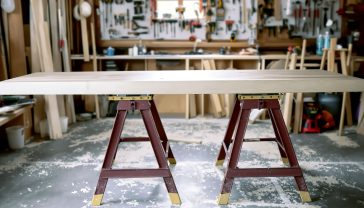From a Gentle Breeze to Powering Your Kettle: The Ultimate Guide to How Wind Turbines Work
Discover the fascinating engineering behind UK wind turbines. This guide breaks down how they work, their history, and their role in our green future.

This post may contain affiliate links. If you make a purchase through these links, we may earn a commission at no additional cost to you.
Ever driven through the rolling British countryside or along our dramatic coastline and spotted them? Towering, graceful structures with huge blades spinning slowly in the wind. They’re becoming an increasingly common feature of our landscape, but they are also a source of intense debate. Have you ever stopped and properly wondered, “How on earth do those giant things actually work?”
On the surface, it’s a simple concept. The wind, the same force that flies a kite, is harnessed to create the electricity that boils your kettle, charges your phone, and powers your home. It’s a significant feat of modern engineering.
But it’s far from a perfect solution, and the reality is complex. This guide is your no-nonsense tour behind the scenes. We’re going to break down exactly how wind turbines work, from the tip of their massive blades right down to the cables buried under the ground. We’ll explore where they came from, the challenges they face, their true impact on our communities, and the ongoing debate about their future role in powering the UK.
So, let’s take a clear-eyed look at the science, the economics, and the controversies surrounding these giants of the British Isles.
What Is a Wind Turbine and What Does It Actually Do?
At its simplest, a wind turbine is a machine that converts the kinetic energy (the energy of movement) from the wind into electrical energy. Think of it like a modern, high-tech windmill. Old-fashioned windmills used the wind to do physical work, like grinding grain into flour or pumping water. Today’s turbines do something similar, but instead of milling flour, they power a generator to create electricity.
They are a major component of renewable energy strategy. Unlike fossil fuels like coal, oil, and gas, which have finite reserves and release greenhouse gases, the wind is a clean and virtually limitless resource. As an island nation often battered by Atlantic gales, the UK is one of the windiest places in Europe, making it a prime location for attempts to harness this natural power.
The Big Idea in a Nutshell: An Aeroplane Wing on a Stick
To get your head around the basic principle, don’t think of a turbine blade as a simple paddle pushing against the wind. It’s a more refined piece of aerodynamics.
Imagine an aeroplane wing. The curved shape of the wing makes the air travel faster over the top than it does underneath. This difference in speed creates a difference in pressure—lower pressure above the wing and higher pressure below it. The result is an upward force called lift, which is what gets a heavy aircraft off the ground.
A wind turbine blade works in exactly the same way, but sideways.
- The Shape is Key: Each blade is essentially an aerofoil, just like an aeroplane wing. It’s curved on one side and flatter on the other.
- Creating Lift: As the wind flows over the blade, it has to travel further and faster over the curved side. This creates a pocket of low pressure on that side.
- The Pulling Force: The higher pressure on the flatter side of the blade then pushes it towards the low-pressure area. This force isn’t a push from behind; it’s a pull from the front. This ‘lift’ is what pulls the blade around.
So, a wind turbine isn’t being pushed by the wind like a pinwheel. It’s being pulled by the aerodynamic force of lift, which allows it to generate power more efficiently. This is why turbines can still turn even in relatively light breezes, although the power they produce in such conditions is minimal.
A Look Inside: The Main Parts of a Wind Turbine
A modern wind turbine is a complex piece of industrial machinery, with several key components working together. While they look simple from a distance, the inside is a hub of complex equipment. Let’s take a tour from top to bottom.
The main parts you can see are the tower, the blades, and the bit they’re connected to, called the nacelle (pronounced ‘nuh-sell’).
The Blades: Capturing the Wind
The blades are meticulously designed to capture the maximum amount of energy from the wind.
- Size and Material: They are enormous. A single blade on an offshore turbine can be over 100 metres long—longer than a football pitch! To be both incredibly strong and relatively lightweight, they are typically made from fibreglass, reinforced with carbon fibre or wood.
- The Twist and Taper: You might notice that the blades aren’t flat. They are twisted from the root (where they connect to the hub) to the tip. This is because the tip of the blade travels much faster than the root. The twist ensures the blade meets the wind at an effective angle all the way along its length, maximising the lift generated.
- Pitch Control: The blades can rotate at their base. This is called pitch control. In very strong winds, the blades can be angled, or ‘feathered’, to spill some of the wind and prevent the turbine from spinning too fast, which could cause damage. In low winds, they can be angled to catch as much wind as possible. This system allows the turbine to operate within a specific range of wind speeds.
The Rotor and Hub
The blades are attached to the hub. Together, the blades and the hub are known as the rotor. The hub houses the pitch control mechanisms for all the blades.
The Nacelle: The Powerhouse in the Sky
The nacelle is the housing that sits at the very top of the tower. If the blades are the hands that catch the wind, the nacelle contains the machinery to convert their motion into electricity. A typical nacelle is about the size of a single-decker bus.
Let’s peek inside:
1. The Main Shaft and Gearbox
As the rotor spins, it turns a low-speed shaft at around 10 to 20 revolutions per minute (RPM). This is far too slow to generate electricity efficiently. To solve this, the shaft connects to a gearbox, which increases the rotational speed to 1,500 RPM or more.
2. The High-Speed Shaft and Generator
The gearbox outputs this rotation to a high-speed shaft connected to the generator. The generator uses electromagnetic induction: as the shaft spins coils of wire inside a magnetic field, it creates an electrical current. This is the moment wind energy becomes electrical energy.
3. The Anemometer and Wind Vane
On top of the nacelle, an anemometer measures wind speed and a wind vane measures wind direction. These instruments feed data to the turbine’s control system.
4. The Yaw System
A turbine must face directly into the wind for maximum efficiency. The yaw system uses motors to turn the entire nacelle to follow the changing wind direction.
5. The Braking System
In dangerously high winds or for maintenance, turbines need to stop. A failsafe mechanical disc brake can halt the blades, but the primary method is using pitch control to feather the blades out of the wind.
The Tower: Reaching for the Sky
The tower, usually made of steel, gives the turbine its height. This is crucial because winds are generally stronger and more consistent higher up. Inside, a lift or ladder allows access for maintenance, and cables carry the electricity down.
The Journey of Power: From Turbine to Your Home
- Down the Tower: Electricity travels down cables inside the tower.
- The Transformer: At the base, a transformer increases the voltage for efficient transport.
- To the Substation: The high-voltage electricity is sent via underground cables to a central substation.
- Joining the National Grid: At the substation, power from the entire wind farm is collated and its voltage is boosted again before being fed into the National Grid.
- Back Down to Your Home: Near its destination, the electricity passes through more substations where the voltage is lowered to a safe level for use in homes and businesses.
A Brief History: From Ancient Windmills to British Super-Structures
- Ancient Origins: The earliest windmills appeared in Persia as early as the 9th century to grind grain and pump water.
- The European Windmill: The classic Dutch-style windmill became common across Europe from the 12th century onwards.
- The Dawn of Electricity: In 1887, Professor James Blyth of Glasgow built a cloth-sailed wind turbine to power his holiday cottage in Kincardineshire, making it the first house in the world to be powered by wind.
- The Modern Era: The 1970s oil crisis spurred serious investment in wind power. The technology developed rapidly, and the first UK wind farm was built in Cornwall in 1991. Today, the UK is a major player in wind energy, especially offshore wind.
Different Types of Wind Turbines
Horizontal-Axis Wind Turbines (HAWTs)
This is the classic, most efficient design you see everywhere. They are categorised into onshore (on land) and offshore (at sea), with offshore turbines being much larger and more powerful due to the stronger, more consistent winds.
Vertical-Axis Wind Turbines (VAWTs)
These are less common and less efficient. They can catch wind from any direction, but they don’t scale up for large-scale power generation.
The Big Questions: A Balanced Look at Wind Turbines
Wind turbines are presented as a key source of clean energy, but their deployment involves significant trade-offs and unresolved challenges.
The Stated Benefits
- Clean Energy Source: When operating, wind turbines produce no greenhouse gas emissions.
- Renewable: The wind is a free and inexhaustible resource.
- Energy Security: Proponents argue that domestic wind power reduces reliance on imported fossil fuels.
- Economic Activity: The industry creates jobs in manufacturing, construction, and maintenance.
The Criticisms and Unresolved Challenges
The Reliability Question: What Happens When the Wind Doesn’t Blow?
This is the most significant operational challenge. Wind is intermittent. There are frequent periods, sometimes lasting days, where wind speeds are too low to generate meaningful amounts of power across the country (known as ‘wind droughts’). In these situations, the grid must rely entirely on other sources. This means that for every megawatt of wind capacity, there must be an equivalent megawatt of reliable, dispatchable power (like gas or nuclear) ready to take over at a moment’s notice. This need for constant backup challenges the idea that wind power can replace conventional power stations on a like-for-like basis.
The Economics: A Reliance on Subsidies
Wind farms are not yet fully self-sufficient and have historically relied heavily on public subsidies to be economically viable for investors. In the UK, this often takes the form of Contracts for Difference (CfDs), where a fixed price for the electricity is guaranteed, with the government paying the difference if the market price falls below it. Critics argue this model insulates operators from market risk at the taxpayer’s expense and questions the technology’s true cost-effectiveness. The long-term economic sustainability of wind power without such support remains a topic of fierce debate.
Lifecycle Environmental Impact
While turbines are clean during operation, their manufacturing and decommissioning are not. Producing the steel, concrete for the foundations, and fibreglass for the blades is an energy-intensive process. Furthermore, recycling the enormous fibreglass blades is a major unresolved environmental challenge, with many ending up in landfills at the end of their 20-25 year lifespan.
Visual and Community Impact
The placement of large wind farms can dramatically alter landscapes, which many people view as industrialisation of the countryside or “visual blight.” This is not just a matter of taste; it has led to vocal opposition and deep divisions within rural communities, with protracted planning battles becoming common.
Noise and Other Concerns
While manufacturers have worked to reduce noise, turbines are not silent. Nearby residents can be affected by a distinct aerodynamic ‘swooshing’ sound, particularly in quiet rural areas. There are strict planning regulations on noise, but disputes still arise.
Impact on Wildlife Bird and bat mortality from blade strikes is a recognised issue. While extensive environmental assessments are required to site farms away from major migration routes, the cumulative impact of thousands of turbines remains a concern for conservation groups.
The Future: An Uncertain Outlook
Wind power is a central pillar of the UK’s current energy strategy, but its future is not guaranteed. For it to succeed, significant hurdles must be overcome. The primary challenge is solving the intermittency problem, which hinges on the development of massive-scale, long-duration energy storage—a technology that is not yet available at the required scale or cost.
The debate is no longer simply about whether wind power is clean, but whether it is reliable, economically sustainable, and truly less impactful on the environment over its full lifecycle than its proponents claim.
These spinning structures are not a simple magic bullet for our energy needs. They represent a complex trade-off: a source of emission-free power that comes with profound challenges related to cost, reliability, and environmental impact. Their ultimate success will depend not just on engineering, but on solving these tough economic and practical questions.
Further Reading
For those interested in delving deeper, here are some highly respected resources on renewable energy in the UK:






